Leaf



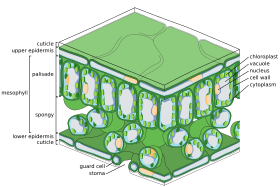

A leaf is a green above-ground plant organ. Its main functions are photosynthesis and gas exchange. A leaf is flat so it absorbs the most light, and thin, so that the sunlight can get to the chloroplasts in the cells. Most leaves have stomata, which open and close. They regulate carbon dioxide, oxygen, and water vapour exchange with the atmosphere.
Plants with leaves all year round are evergreens, and those that shed their leaves are deciduous. Deciduous trees and shrubs generally lose their leaves in autumn. Before this happens, the leaves change colour. The leaves will grow back in spring. Leaves are normally green in color, which comes from chlorophyll found in the chloroplasts. Plants that lack chlorophyll cannot photosynthesize.
Leaves come in many shapes and sizes. The biggest undivided leaf is that of a giant edible arum. This lives in marshy parts of the tropical rain forest of Borneo. One of its leaves can be ten feet across and have a surface area of over 30 square feet (~2.8 sq. metres).[1]
However, leaves are always thin so carbon dioxide can diffuse quickly to all cells.
Anatomy[change | change source]
A leaf is a plant organ made up of tissues in a regular organisation. The major tissue systems present are:
- The epidermis that covers the upper and lower surfaces
- The mesophyll (also called chlorenchyma) inside the leaf that is rich in chloroplasts
- The arrangement of veins (the vascular tissue)
Epidermis[change | change source]
The epidermis is the outer layer of cells covering the leaf. It forms the boundary separating the plant's inner cells from the external environment.
The epidermis is covered with pores called stomata. Each pore is surrounded on each side by chloroplast-containing guard cells, and two to four subsidiary cells. Opening and closing the stoma complex controls the exchange of gases and water vapor between the outside air and the interior of the leaf. This allows photosynthesis, without letting the leaf dry out.
Mesophyll[change | change source]
Most of the interior of the leaf between the upper and lower layers of epidermis is a tissue called the mesophyll (Greek for "middle leaf"). This tissue is the main place photosynthesis takes place. The products of photosynthesis are sugars, which can be turned into other products in plant cells.
In ferns and most flowering plants, the mesophyll is divided into two layers:
- An upper palisade layer of tightly packed, vertical cells, one to two cells thick. Its cells contain many chloroplasts. The chloroplasts move by a process called "cyclosis". The slight separation of the cells provides maximum absorption of carbon dioxide. Leaves in the Sun have a multi-layered palisade layer, while shade leaves closer to the soil are single-layered.
- Beneath the palisade layer is the spongy layer. The cells of the spongy layer are more rounded and not so tightly packed. There are large air spaces between the cells. These cells contain fewer chloroplasts than those of the palisade layer. The pores or stomata of the epidermis open into chambers, which are connected to the air spaces between the spongy layer cells.
Plants with leaves all year round are evergreens, and those that shed their leaves are deciduous. Deciduous trees and shrubs generally lose their leaves in autumn. Before this happens, the leaves change colour. The leaves grow back in Spring.
Veins[change | change source]
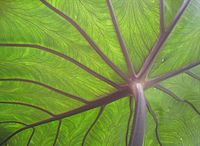
The 'veins' are a dense network of xylem, which supply water for photosynthesis, and phloem, which remove the sugars produced by photosynthesis. The pattern of the veins is called 'venation'.
In angiosperms the pattern of venation differs in the two main groups. Venation is usually is parallel in monocotyledons, but is an interconnecting network in broad-leaved plants (dicotyledons).
Hairs[change | change source]
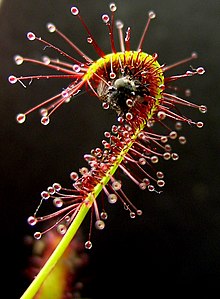
Many leaves are covered in trichomes (small hairs) which have a wide range of structures and functions. Some trichomes are prickles, some are scaled, some secrete substances such as oil. Carnivorous plants secrete digestive enzymes from trichomes.
Waxy cuticle[change | change source]
The waxy cuticle is the waterproof, transparent outer surface of the leaf. It is waterproof to reduce water loss (transpiration) and transparent to allow light to enter the palisade cell.
Shape[change | change source]
What leaves look like on the plant varies greatly. Closely related plants have the same kind of leaves because they have all descended from a common ancestor. The terms for describing leaf shape and pattern is shown, in illustrated form, at Wikibooks.
Basic types[change | change source]

- Lycophytes have microphyll leaves.[2]
- Ferns have fronds
- Conifer leaves are typically needle-, awl-, or scale-shaped
- Angiosperm (flowering plant) leaves: the standard form includes stipules, a petiole, and a lamina
- Sheath leaves (type found in most grasses)
- Other specialized leaves (such as those of Nepenthes)
Arrangement on the stem[change | change source]
Different terms are usually used to describe leaf placement (phyllotaxis):
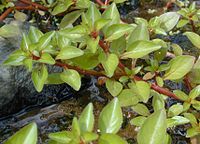
- Alternate — succeessive leaves in alternate direction along the stem.
- Opposite — Two structures, one on each opposite side of the stem, typically leaves, branches, or flower parts.
- Whorled — three or more leaves attach at each point or node on the stem.
Leaves form a helix pattern centered around the stem, with (depending upon the species) the same angle of divergence. There is a regularity in these angles and they follow the numbers in a Fibonacci sequence. This tends to give the best chance for the leaves to catch light.
Divisions of the blade[change | change source]
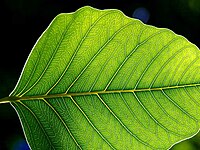
Two basic forms of leaves can be described considering the way the blade (lamina) is divided.
- A simple leaf has an undivided blade. However, the leaf shape may be formed of lobes, but the gaps between lobes do not reach to the main vein.
- A compound leaf has a fully subdivided blade, each leaflet of the blade separated along a main or secondary vein. Because each leaflet can appear to be a simple leaf, it is important to recognize where the petiole occurs to identify a compound leaf. Compound leaves are a characteristic of some families of higher plants, such as the Fabaceae. The middle vein of a compound leaf or a frond, when it is present, is called a rachis.
Petioles[change | change source]

Some leaves have a petiole (leaf stem). Sessile leaves do not: the blade attaches directly to the stem. Sometimes the leaf blade surrounds the stem, giving the impression that the shoot grows through the leaf.
In some Acacia species, such as the Koa Tree (Acacia koa), the petioles are expanded or broadened and function like leaf blades; these are called phyllodes. There may or may not be normal pinnate leaves at the tip of the phyllode.
Stipules[change | change source]
A stipule, present on the leaves of many dicotyledons, is an appendage on each side at the base of the petiole resembling a small leaf. Stipules may be shed or not shed.
Leaf adaptations[change | change source]

In the course of evolution, many species have leaves which are adapted to other functions.
- Thorns help protect the plant from being eaten.
- Vines help the plant to attach to surfaces, and helps to climb trees.
- Some leaves are used to store energy in bulbs. An example is the onion.
- Many succulents store water in some of their leaves.
- Some plants (called epiphytes) grow on other plants. They do not have roots in the ground. They capture rainwater.
- Carnivorous plants use leaves adapted to capture their prey.
- Sliced leaves reduce wind resistance.
- Hairs on the leaf surface trap humidity in dry climates.
- Waxy leaf surfaces reduce water loss.
- Large surface area provides area for sunlight and shade for plant to minimize heating and reduce water loss.
- In more or less opaque or buried in the soil leaves, translucent windows let the light in.
- Succulent leaves store water and organic acids.
- Aromatic oils, poisons or pheromones produced by leaf borne glands deter herbivores (e.g. eucalyptus).
- Crystalline minerals may herbivores (e.g. silica phytoliths in grasses, raphides in Araceae).
- Petals attracts pollinators.
- Tendrils allow the plant to climb (e.g. peas).
- Bracts and 'false flowers' replace normal flower structures when the true flowers are greatly reduced (e.g. Spurges).
